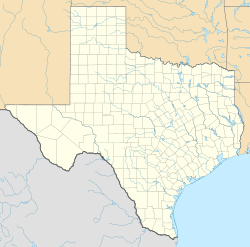Joinerville, Texas
| Joinerville, Texas | |
|---|---|
| Unincorporated community | |
| Location within the state of Texas | |
| Coordinates: 32°10′41″N 94°54′03″W / 32.17806°N 94.90083°WCoordinates: 32°10′41″N 94°54′03″W / 32.17806°N 94.90083°W | |
| Country | United States |
| State | Texas |
| County | Rusk |
| Time zone | Central (CST) |
Joinerville is an unincorporated community in East Texas. It is located in western Rusk County, Texas, United States.
Joinerville is seven miles west of the City of Henderson, Texas. It was originally called Cyril, and then Miller or Miller Schoolhouse until 1930, when the name was officially changed to "Joinerville" to honor a prominent oilman who discovered the world's largest oilfield (the East Texas Oil Field) just a couple of miles away. The community is also located near the site of a former Cherokee Indian village.
During the oil-boom years that followed 1930, men and families flocked to East Texas to find work in the oilfields and Joinerville's population shot up to 1,500. During the 1930s, the community that had been nothing more than a sleepy farm town, now had thirty-five businesses and a brand new post office (established in 1931 with Esther L. Berry as the first postmistress). However, by 1940, new oil production had already peaked and the town's population quickly dropped to just 500. Over the decade that followed, the number of residents continued its downward spiral to 350 and the number of reported businesses dropped to just four. After a slight upswing during the 1950s and 1960s, the population again fell greatly. From 1980 through 2000, Joinerville reported just 140 residents and four businesses.
By 1950, while the existing oil wells continued to pump 20 years after discovery of the oilfield (many still pumping to this day), the need to drill new wells had long passed. With work drying up, most of the families who had lived and worked side-by-side for more than a decade left Joinerville.
Over the span of 20 years, Joinerville had exploded from nothing more than a speck on the map, to a boom-town, and back. Most all of the old buildings from its heyday are long gone and all that remains are pastures and memories of a time when Joinerville mattered, not just to Texas but, because of World War II, the world. Oil was needed in large quantities to support the war effort and East Texas could produce it.
The Gaston School was built in 1925, as a result of a merger between two existing schools - Miller and Mount Hope. Irene Gaston, a teacher at the Mount Hope school, donated the land on which the new school was built, and it was named Gaston after Irene and her husband Hugh.
The school was originally built to house 80 pupils. Following the discovery of oil and the expansion of Cyril, it was considerably expanded. In 1932, the Henderson Daily News referred to it as "the largest rural school in the world". The rebuilt school featured ten buildings, expansive sports facilities, and striking walls of native rock surrounding the campus.
...
Wikipedia


